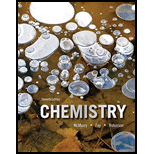
Use the data in Appendix B to calculate ΔH°, ΔS°, and Δ°G at25 °C for each of the following reactions:
(a)
(b)
(c)
(d)
Are these reactions spontaneous or nonspontaneous at 25 °C and 1atm pressure? How does ΔG° change when the temperature is raised?
Want to see the full answer?
Check out a sample textbook solution
Chapter 17 Solutions
Chemistry
- From the values for G f given in Appendix 1, calculate G at 25C for each of the reactions in Question 19.arrow_forwardUsing values of fH and S, calculate rG for each of the following reactions at 25 C. (a) 2 Na(s) + 2 H2O() 2 NaOH(aq) + H2(g) (b) 6 C(graphite) + 3 H2(g) C6H6() Which of these reactions is (are) predicted to be product-favored at equilibrium? Are the reactions enthalpy- or entropy-driven?arrow_forwardThere are millions of organic compounds known, and new ones are being discovered or made at a rate of morethan 100,000 compounds per year. Organic compoundsburn readily in air at high temperatures to form carbondioxide and water. Several classes of organic compoundsare listed, with a simple example of each. Write a balanced chemical equation for the combustion in O2ofeach of these compounds, and then use the data inAppendix J to show that each reaction is product-favoredat room temperature. From these results, it is reasonable to hypothesize thatallorganic compounds are thermodynamically unstable inan oxygen atmosphere (that is, their room-temperaturereaction with O2(g) to form CO2(g) and H2O() isproduct-favored). If this hypothesis is true, how canorganic compounds exist on Earth?arrow_forward
- Yeast can produce ethanol by the fermentation of glucose (C6H12O6), which is the basis for the production of most alcoholic beverages. C6H12O6(aq) 2 C2H5OH() + 2 CO2(g) Calculate rH, rS, and rG for the reaction at 25 C. Is the reaction product- or reactant-favored at equilibrium? In addition to the thermodynamic values in Appendix L, you will need the following data for C6H12O6(aq): fH = 1260.0 kl/mol; S = 289 J/K mol; and fG = 918.8 kl/mol.arrow_forwardFor each process, predict whether entropy increases or decreases, and explain how you arrived at your prediction. 2 CO2(g) → 2 CO(g) + O2(g) NaCl(s) → NaCl(aq) MgCO3(s) → MgO(s) + CO2(g)arrow_forwardOn the basis of your experience, predict which reactions are spontaneous: (a) PbO2(s)Pb(s)+O2(g)(b) N2(l)N2(g) at 25C (c) C6H12O6(s)C6H12O6(l) at 25C (d) Ca2+(aq)+CO32(aq)CaCO3(s)arrow_forward
- What is meant by the standard free-energy change G for a reaction? What is meant by the standard free energy of formation Gf of a substance?arrow_forwardThe combustion of methane can be represented as follows: a. Use the information given above to determine the value of H for the combustion of methane to form CO2(g) and 2H2O(l). b. What is Hf for an element in its standard state? Why is this? Use the figure above to support your answer. c. How does H for the reaction CO2(g) + 2H2O (1) CH4(g) + O2(g) compare to that of the combustion of methane? Why is this?arrow_forwardFor the reaction NO(g)+NO2(g)N2O3(g) , use tabulated thermodynamic data to calculate H and S. Then use those values to answer the following questions. (a) Is this reaction spontaneous at 25°C? Explain your answer. (b) If the reaction is not spontaneous at 25°C, will it become spontaneous at higher temperatures or lower temperatures? (c) To show that your prediction is accurate, choose a temperature that corresponds to your prediction in part (b) and calculate G . (Assume that both enthalpy and entropy are independent of temperature.)arrow_forward
- For each of the following processes, identify the systemand the surroundings. Identify those processes that arespontaneous. For each spontaneous process, identify theconstraint that has been removed to enable the process to occur: Ammonium nitrate dissolves in water. Hydrogen and oxygen explode in a closed bomb. A rubber band is rapidly extended by a hangingweight. The gas in a chamber is slowly compressed by aweighted piston. A glass shatters on the floor.arrow_forwardThe molecular scale pictures below show snapshots of a strong acid at three different instants after it is added to water. Place the three pictures in the correct order so that they show the progress of the spontaneous process that takes place as the acid dissolves in the water. Explain your answer in terms of entropyarrow_forward
 Chemistry: Principles and PracticeChemistryISBN:9780534420123Author:Daniel L. Reger, Scott R. Goode, David W. Ball, Edward MercerPublisher:Cengage Learning
Chemistry: Principles and PracticeChemistryISBN:9780534420123Author:Daniel L. Reger, Scott R. Goode, David W. Ball, Edward MercerPublisher:Cengage Learning Principles of Modern ChemistryChemistryISBN:9781305079113Author:David W. Oxtoby, H. Pat Gillis, Laurie J. ButlerPublisher:Cengage Learning
Principles of Modern ChemistryChemistryISBN:9781305079113Author:David W. Oxtoby, H. Pat Gillis, Laurie J. ButlerPublisher:Cengage Learning Chemistry: Principles and ReactionsChemistryISBN:9781305079373Author:William L. Masterton, Cecile N. HurleyPublisher:Cengage Learning
Chemistry: Principles and ReactionsChemistryISBN:9781305079373Author:William L. Masterton, Cecile N. HurleyPublisher:Cengage Learning Chemistry: The Molecular ScienceChemistryISBN:9781285199047Author:John W. Moore, Conrad L. StanitskiPublisher:Cengage Learning
Chemistry: The Molecular ScienceChemistryISBN:9781285199047Author:John W. Moore, Conrad L. StanitskiPublisher:Cengage Learning Chemistry & Chemical ReactivityChemistryISBN:9781337399074Author:John C. Kotz, Paul M. Treichel, John Townsend, David TreichelPublisher:Cengage Learning
Chemistry & Chemical ReactivityChemistryISBN:9781337399074Author:John C. Kotz, Paul M. Treichel, John Townsend, David TreichelPublisher:Cengage Learning Chemistry & Chemical ReactivityChemistryISBN:9781133949640Author:John C. Kotz, Paul M. Treichel, John Townsend, David TreichelPublisher:Cengage Learning
Chemistry & Chemical ReactivityChemistryISBN:9781133949640Author:John C. Kotz, Paul M. Treichel, John Townsend, David TreichelPublisher:Cengage Learning





